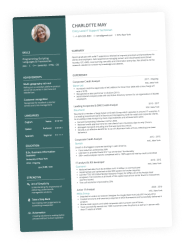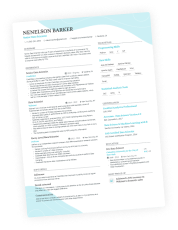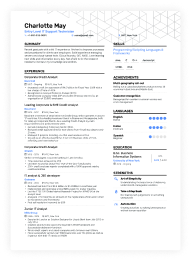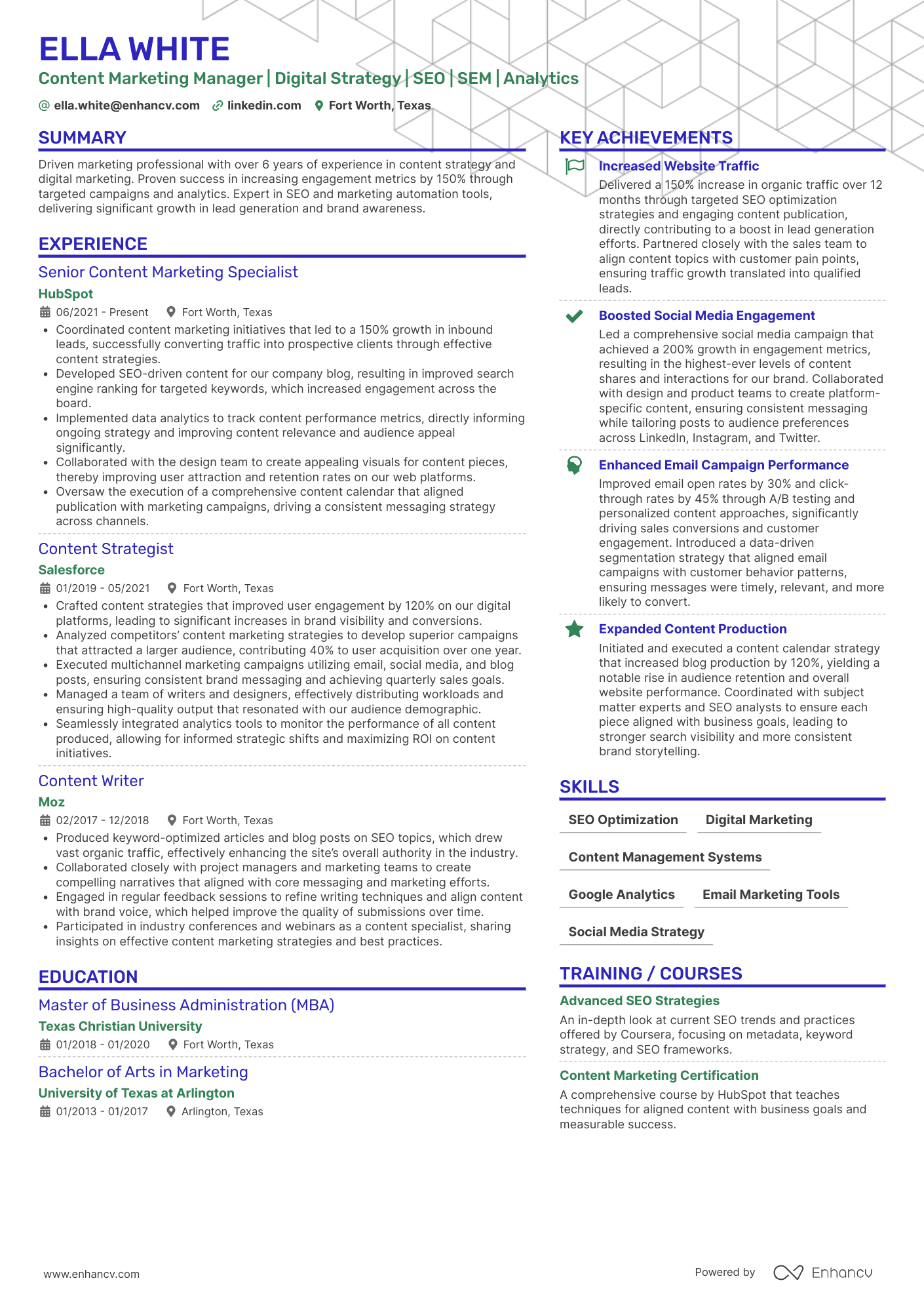One of the most common sticking points when writing a resume is whether to use bullet points or paragraphs.
It seems like such a small detail. Then you start to wonder if hiring managers have a preference. What about applicant tracking systems—could the wrong format hurt your chances?
There’s a lot to consider, so let’s unpack this conundrum and see what really works when building a resume.
Key takeaways
- Resume formatting and readability matter because they shape how quickly and clearly your value comes across.
- There’s no single “best” format—what works depends on the section of the resume and the story you want to tell.
- Balance is often the most effective approach—different sections benefit from different styles.
- Applicant tracking systems (ATS) can read both bullets and paragraphs, but keyword visibility is what matters the most.
- Consistency across the resume makes it easier for hiring managers to follow the narrative.
Overview of bullet points vs. paragraphs
Both bullet points and paragraphs have a place and purpose on a resume. It’s less about which is the better option and more about finding the best way to present your qualifications, experience, and skills.
Let’s examine their main facets to gain some clarity.
Key differences at a glance
| Bullet points | Paragraphs |
|---|---|
| One or two lines per point | Three to five sentences per paragraph |
| Concise and impactful | Risk of being too dense |
| Easy to skim | Require deeper reading |
| Emphasis on accomplishments and metrics | Provide context and fuller explanations |
| Direct, matter-of-fact tone | Conversational, descriptive narrative |
| Overuse can make resumes look like laundry lists | Long walls of text reduce skimmability |
A conclusion we can draw from this comparison is that bullet points have the upper hand when it comes to readability. But this doesn’t mean you should forget about using paragraphs entirely.
Paragraphs are rare in resumes—that’s what makes them valuable. They offer context you can’t easily convey through bullet points alone.
Rory Miller, CPRW
Here’s an example of resume bullet points and paragraphs working together on a resume. We used one of Enhancv’s ATS-friendly templates to create this two-column resume.
So, how do we balance the two formats, then? And how do we choose the right one for each resume section? Let’s break it down.
Where to use bullet points on a resume
Recruiters are known to skim through resumes before they decide whether to give them a second look. Bullet points allow you to bring their attention to your most relevant accomplishments and qualities.
The best resume sections to use them include:
- Work Experience: You can break down each role into notable accomplishments.
- Skills: Prominently listing your professional abilities ensures they don’t get lost in text.
- Education & Certification: Focus on key facts, such as institution names and credentials, without going into too much detail.
- Achievements: Usually, a bulleted list offers enough context without overwhelming the reader with narrative. However, in some industries such as marketing or various creative fields, deeper explanations offered through concise paragraphs could be beneficial.
Using bullet points is great, but you still need to write them in a way that commands attention and offers value.
How to make your bullet points more impactful
Effective bullet points can be the difference between landing a job interview and being ignored.
Here’s how to make yours count:
- Focus on outcomes: Instead of listing duties and tasks, write about what you accomplished or improved.
- Quantify results: Make your achievements more credible by using numbers.
- Lead with action verbs: Begin each bullet point with a strong verb (e.g., increased, developed, led) to emphasize initiative and impact.
- Tailor to the job: Align your content with hiring decision-makers and ATS by using keywords from the job description.
- Keep them concise: Maintain the readability of your document by aiming for one to two lines per bullet point.
If you need some help with this, Enhancv’s AI-integrated Resume Builder has a built-in Bullet Point Generator.
We used it to create this example:
- •Streamlined data migration from mainframe to early cloud environments, reducing transfer errors by 35%.
- •Developed automation scripts in Perl to replace manual reporting processes, saving 20+ staff hours weekly.
- •Collaborated with cross-functional teams to integrate legacy payroll systems with new ERP software, enabling smoother HR operations for 1,500+ employees.
When it comes to impact and volume, it sure seems like bullet points are the star of the show. But once you have the reader’s attention, a couple of well-placed paragraphs can truly pique their interest in you.
Where to use paragraphs on a resume
Certain sections benefit from a short paragraph. They provide some much-needed narrative to help the reader understand who you are.
These include:
- Summary: A brief introduction at the beginning of your document that sets the tone for the rest of your content.
- Objective (if used): A short statement about your career goals—often used by career transitioners and early-stage professionals.
- Projects: A paragraph can explain the scope before you detail your contributions through bullet points.
It’s worth mentioning a certain resume add-on because it’s a natural place for paragraph-style writing—the cover letter.Your resume serves the purpose of presenting concise achievements but your cover letter supports your career narrative.
While it’s a separate document, it can be a major part of your application. The fact that you can tell your story and connect with hiring managers on a personal level is precisely what makes it a strong asset.
Cover letters improve your chances
About 74% of hiring decision-makers prefer applications that include cover letters.
How to make your paragraphs more impactful
Well-written paragraphs complement your resume bullet points beautifully by showing employers the bigger picture.
Here are some best practices:
- Keep them short: Aim for three to four sentences per paragraph.
- Stay focused: Establish what topic you’re addressing and stick to it.
- Exude confidence: Your writing tone should reassure the reader you’re a capable, determined professional.
- Lead with important points: Mention the impressive details right from the start.
- Tailor to the role: Weave keywords from the job description naturally into the sentences.
We used Enhancv’s Summary Generator to create this example:
Industries where resume paragraphs can make a stronger impact
It’s worth mentioning that in some industries a resume could benefit from including more paragraphs.
Here are some examples.
Paragraph-friendly industries at a glance
| Industry | Specifics |
|---|---|
| Marketing | Paragraphs are useful for explaining campaigns and brand impact. |
| Creative industries (e.g., design, writing, media) | Employers want to learn about the applicant’s vision, creativity, and personal style beyond measurable outcomes. |
| Public relations | Explaining relationship management, media strategy, and crisis communications often benefits from narrative detail. |
| Education | Educators may need to describe their teaching philosophy or curriculum design in a way that bullets alone can’t capture. |
| Human resources | Paragraphs can be used to go deeper into explaining leadership style, conflict resolution skills, and approaches to employee engagement. |
| Research | Summaries of research focus, methodologies, or scholarly contributions may require explanatory text. |
| Nonprofit management | Short paragraphs can help convey mission alignment, fundraising strategies, and community impact. |
We covered the best practices, but there are also some major pitfalls when writing resume bullet points or paragraphs.
Common resume bullet points and paragraph mistakes
Be careful when working on your resume, as certain writing missteps can ruin your chances with most employers.
Bullet points mistakes
- Describing job duties instead of accomplishments.
- Overloading each role with too many bullets—creating cluttered lists.
- Starting every bullet the same way, making them blend together.
- Writing bullets that are too long and look like paragraphs.
Paragraphs mistakes
- Writing blocks of text that reduce readability and overwhelm the reader.
- Using buzzwords and cliches like “results-driven,” “hard worker,” and “go-getter” instead of solid examples of accomplishments.
- Ignoring keywords risks ATS skipping the paragraph.
- Using a writing tone that doesn’t match the vibe of the employer.
A red flag related to both bullet points and paragraphs is inconsistency. Switching the format too often without a reason can make your resume look unfocused and messy.
Frequently asked questions about bullet points and paragraphs
There are a few unanswered questions that applicants usually have.
Do hiring managers read paragraphs at all?
Yes. They skim most documents at first, but they read the ones that grab their attention more thoroughly.
Does using bullet points or paragraphs matter for ATS?
Modern systems read both equally well. As long as you follow format best practices such as breaking down your content into relevant resume sections, bullet points, and concise paragraphs, and use keywords properly, there won’t be any issues with your documents.
Are there cases where paragraphs would work better than bullet points?
You might have to rely more on paragraphs if you’re using a functional resume or a hybrid format, and you need to explain better how your transferable skills relate to the role.
How's my resume length affected by using more bullets or paragraphs?
The recommendations don’t change. You should still aim for a one-page resume. Depending on your industry, a two-page resume can work too.
How many bullet points per job is ideal?
We generally recommend having three to five bullet points per job entry on your resume. In some instances, such as for executive-level roles, an exception is made and they can benefit from longer lists.
Conclusion: Balance is key
A strong resume uses both bullet points and paragraphs intentionally. Each format serves a clear purpose.
To gain a sense of direction, ask yourself:
- What do I want hiring managers to notice first?
- Where do I need to provide context to improve clarity?
- How can I add a punch through brevity?
The answers will offer you quick guidance when making format decisions about your resume sections.
Make one that's truly you.




